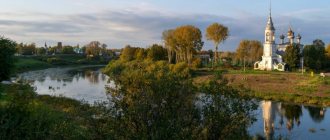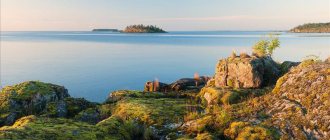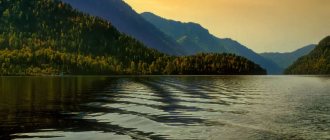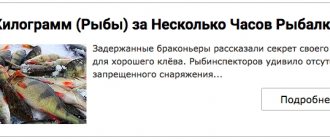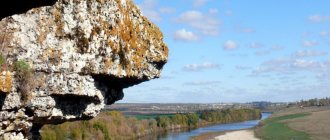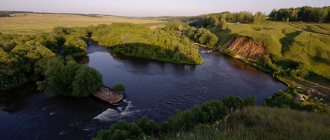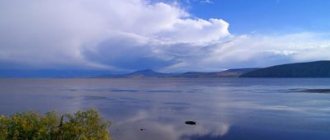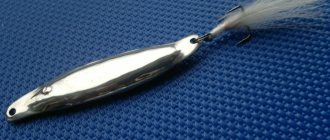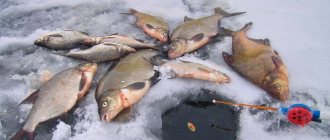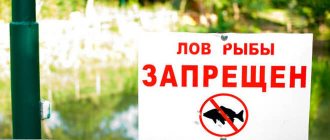Reservoirs of the Novgorod region
Fishing in the reservoirs of the Nogorod region
Volkhov River
- a river flowing from Lake Ilmen flows into Lake Ladoga. Representatives of both lakes live here: salmon, catfish, pike, pike perch, perch, ruff, burbot, sabrefish, asp, ide, chub, tench, carp, bream, sop, bluegill, white-eye, silver bream, rudd, roach, bleak, crucian carp, loach. The Volkhov flows through the Novgorod and Leningrad regions. It has many tributaries, including some interesting for anglers.
Lovat River
- is considered the largest river in the region. A winding channel with complex terrain and varying currents provides a lot of scope for choosing catching points. The pools in Lovat reach a depth of more than six meters, and rocky shallows and rapids are often found. Here live: perch, pike, asp, ide, pike perch. Fans of white fish fishing will be interested in: catfish, bream, roach, tench and silver bream. It flows through the Vitebsk, Pskov and Novgorod regions.
Kunya River
is a tributary of the Lovat River, inferior to it in width. It has the same winding channel as the Lovat, with the same uneven relief and flow. In Kunya, the species composition of fish is actually the same as in the main water vein of the region - Lovat.
The Big and Small Tudera rivers
- tributaries of the Kunya. They abound in rifts and become very shallow in the summer. Here, in addition to other inhabitants of the reservoir, you can meet trout and chub.
Msta River
originates from Lake Mstino, flows into Lake Ilmen from the northern side of the lake, not far from the source of the Volkhov, forming an extensive swampy delta in the Ilmen lowland. Large tributaries of the Msta River: Berezayka, Shegrinka, Peretna, Linenaya, Kholova, Uver, Belaya, Mda, Huba . The river is home to pike, perch, pike perch, catfish, asp, chub, ide, bream, roach, silver bream, white-eye, bleak, quicksand, gudgeon, ruff, loach, and spined loach. Occasionally we come across burbot.
Lake Ilmen
is considered one of the largest in European Russia. Almost all major rivers of the Nizhny Novgorod region flow into Ilmen, and only the Volkhov River flows out. Almost all species of fish typical for this region live here, including saberfish, bluefish and smelt. The volume of water in the lake is colossal and during a flood its level rises to seven meters. At the same time, the area occupied by the water surface of the lake increases up to three times.
Lake Seliger
also includes more than a hundred rivers. This is an ancient lake of glacial origin with rugged shores, where capes and bays adjoin. There are many islands on the lake itself, near which there is always fish. Seliger is home to several dozen species, of which spinning anglers will be interested in perch, pike and pike perch, and hunters of peaceful fish will be interested in bream. There are also ide and burbot, and sometimes rarer species such as vendace or smelt are also found in the bycatch.
Lake Valdai
is divided into two reaches with a large number of islands. Its banks are mostly covered with untouched forest, and the water is considered one of the cleanest in Russia. Compared to Ilmen and Seliger, Lake Valdai is relatively small, but the depth differences in some places reach fifty meters.
Lake Velje
— located north of Lake Seliger on the territory of the Valdai National Park. The depths of the lake reach 42 meters. Lake Velje is rich in bream, pike, perch, pike perch, roach, ruffe, rudd, crucian carp, burbot, ide, eel, whitefish and crayfish.
How to get there
The lake is located in the Khvoininsky district of the Novgorod region, 220 km from Veliky Novgorod and 320 km from St. Petersburg. The best way to get to your destination is by personal or rented transport or taxi.
You can get there from the administrative center of the Novgorod region in a maximum of 3 hours. You need to move along road 49K-13, passing the village. Lyubino, the village of Burgu and the town of Malaya Vishera. You can also get there along the M-11 highway through the village. Lyubino, the city of Borovichi, the city of Okulovka, the village of Posad. But here it is worth noting that the section of the road from the village. Lyubytino to Borovichi - requires major repairs.
From the northern capital to your destination, the journey will take about 4-4.5 hours. You need to take the route along the M-11 or E-105 highway to the village of Spasskaya Polist. Then you will have to turn onto road 49K-13 and pass the town of Malaya Vishera, village. Lyubino, get to Lake Gorodno.
To order a car to the lake from large cities, you can use local taxi services, but you should immediately clarify the time of return, since the villages around the reservoir are very small and do not have their own services.
© zlastepa
Features of fishing in the region
Names such as Valdai, Ilmen, Seliger are familiar to many people, not just fishermen.
There are legends about the fabulous beauty of these places. A huge number of people dream of visiting there, much less relaxing in those places for at least a few days. What can we say about the fishermen? For them, these are generally protected places. Fishing in the Novgorod region
Fishing in the Novgorod region on lakes Ilmen, Seliger, Valdai is the cherished dream of many fishermen. But in addition to incredibly beautiful and picturesque lakes, the Novgorod region has a large number of incredibly beautiful and picturesque rivers. Lovat, Seyda, Volkhov, Kunya, Usa and many others. And the fame of the fish riches of these places has long been known outside the region.
Winter fishing on Lake Ilmen
Like any other body of water, winter fishing on Ilmen has its own characteristics. The best way to get to the fishing spot on the lake is by snowmobile. Even at high speed, it has excellent maneuverability, which makes it easy to avoid thawed patches and ice hummocks.
The lake has an area of more than 700 km², and fishermen in search of the treasured place can travel quite far from the shore. And during floods after the ice melts, the width of the lake increases many times over. On the territory of Russia, this is the only reservoir with a water level difference of about 7 meters, and the surface of the lake can increase almost 3 times.
Winter fishing in the Novgorod region on Lake Ilmen is attractive not only for local residents. Under favorable conditions and weather, catches can be very good and amount to tens of kilograms. On Ilmen, the beginning of March is still deep winter, that is, the fish are inactive at this time. But in a couple of weeks, when the time comes for the ice to melt, and through the formed thawed patches the water will be well saturated with oxygen, its activity will increase greatly.
After the angler decides on the fishing spot, he must decide on the fishing method. Either start trolling and catch predatory fish, or start catching white fish with a jig. The first option is more suitable for active fishermen, but it will require changing places and drilling many holes.
Fishermen who come to fish from other regions note that, for example, if you compare local perch of the same age with perch from other places, for example from the Oka, then the perch from Ilmen is one and a half, or even twice as large. In a food-rich and spacious reservoir, it grows and gains weight quickly. Local fishermen who have been fishing on Ilmen for many years usually catch perch with their own gear. So, for example, near the village of Bronnitsy, located near the lake, local craftsmen make spinners of a certain shape.
There are two types of metal used to make such a spinner: the outer side is made of steel, and the inner side is made of brass. This lure has a length of about 50 mm, and at its widest part it is 7 mm. The bait has the usual tetrahedral shape, but the secret of this bait is the smooth bend of the spoon at a certain angle. Freely falling in the water, the bait encounters resistance and begins to make rhythmic, jerky movements, which attracts the attention of predatory fish. People call this bait “Bornnitsa spinner.” Many years of experience helped local craftsmen calculate the optimal length and width of the spoon and, most importantly, what angle the spoon should have. Such a spoon, moving at depth, is very reminiscent of the movements of a weakened fry; such fry are easy prey for a predator and are attacked first of all. Of course, you can catch perch with a jig, but using the trolling method, the search for a predator is much faster; the active movement of the bait makes the perch show itself more often. Fishing in the Novgorod region for predators using a Bronnitsky spoon is very catchy.
A small, weighty Bronnitsky spoon quickly reaches the bottom, and is a good way to help the fisherman explore the bottom topography, as well as assess the prospects of the fishing spot.
In addition, the bait is capable of creating acoustic vibrations in the water column and attracting predators from a long distance. The jig does not possess such qualities. Winter fishing on Lake Ilmen
But successful trolling largely depends not only on the correctly chosen bait, but also on the correct rhythmic movements of the angler with the fishing rod. As a rule, the spoon is lowered to the bottom and, after hitting the bottom, it is again raised above the bottom surface and lowered again. The whole secret is to correctly determine the duration of the pause, which can last from 3 to 5 seconds. During a sharp change in the rhythm of the bait’s movement, the perch may become wary and only watch its play, but not grab it. In some cases, it is recommended to drag the spoon a little along the bottom to raise the turbidity, which can arouse the interest of a predator. And tempt him to take the bait.
Of course, few even experienced fishermen would undertake to predict the success of winter fishing, especially when it comes to perch. This fish does not like to go far from its usual habitats, but there are times when the perch completely changes its feeding and stopping place. The activity of many fish, including perch, depends on pressure changes, and makes its behavior less predictable. It can abruptly reach the upper layers of water, and then just as abruptly go deeper.
Perch is one of the most common types of fish in Ilmen and fishing in the Novgorod region in Lake Ilmen for perch is of interest to many fishermen. The best time to catch a striped predator is considered to be freezing ice, but you have to walk a lot on the ice and drill holes, as schools of perch actively move around the lake in search of food. Those who are not lazy and actively search for perch in a pond, as a rule, are lucky. So on average, in one fishing trip in the lake you can catch up to 50 kg of perch. But sometimes you have to look for this fish all over the lake. Typically, a school of perch can consist of 4-8 individuals.
Due to the good flow of Ilmen, the water in the lake changes every 2-3 months; if we compare it, for example, with Lake Ladoga, then in the latter the water changes only once every 12 years. Such a rapid change of water occurs due to the large number of influxes feeding the lake. The largest tributaries of Ilmen are Msta, Lovat, Pola, Shelon, and only the large and deep Volkhov River flows out of the lake.
Ilmen is characterized by sudden changes in weather, especially during the off-season. Strong and gusty winds often occur on Ilmen; there have been cases when even cars parked on ice are moved by the wind. Many anglers use ski poles while walking. But the lake is considered safe for fishing even when the ice is melting. Unlike Lake Ladoga, where a breakaway ice floe can be carried very far in any direction, on Ilmen they fish from the ice until mid-April. Local fishermen say that Ilmen looks like a saucer with ice cream in the middle. In the reservoir, the ice begins to melt at the edges and thus a huge floating island is formed in the middle, which washes up to one side or the other, depending on the direction of the wind.
There is some deceit in this state of affairs. It happens that a fisherman, having finished fishing, returns to the place from which he entered the lake and discovers a “bank” - this is the name given to the formed water boundary between the ice and the shore. In March, the ice is still very strong and the lake generously rewards fishermen with good catches.
Fishing by month
Fishing in Veliky Novgorod
- In January, white fish become active. It can be caught with bloodworms, maggots or small baits for bream, roach, and silver bream. Predatory fish must be caught using vertical lures. Dim jigs have proven themselves well with a weight of up to ten grams. You can feed the fish with breadcrumbs, porridge, and bread.
- In February, when there are sharp changes in temperature, predatory fish will bite well. On the Volga, it is possible to catch bersh and pike perch. They use live bait for profit, and find calmer and quieter places to catch the fish.
- March is a good time to catch predatory and peaceful fish. She swims in search of food. Pike feeds on the eve of spawning.
- The fishing season opens in April. The fish hides in holes and at great depths. You can fish with various artificial baits and live bait. Predatory fish also hide in quiet places. In mid-April, catfish begin to feed and can be caught with a frog or crucian carp.
- In May, pike perch begins to guard their nests. The attack of fanged fish is dictated not by hunger, but by defense of its territory. With the spring streams, many other fish appear in the lakes. Predators are very hungry and can be caught.
- All types of fish, from small to large, feed actively in June. From mid-June, other peaceful fish also begin to bite.
- In July, the fish move to the rapids and stay near the rifts. At night, pike perch begins to be awake; it is easiest to catch them at dawn or sunset.
- The most active time for fishing is August. You can catch a predator using spoons.
- Fishing also continues well into September. You can catch a variety of fish with a spinning rod, and crucian carp, perch, and carp will be caught well with a fishing rod.
- In October, the fish begin to prepare for winter. She bites almost every day, as she begins to actively feed. For profit, you can use bait of animal and plant origin.
- The most successful catch of pike perch in the Novgorod region is in November; it grows and constantly produces food.
- On reservoirs in December, when the ice appears and becomes strong, the fish begin to bite, and you can catch it with a vertical lure.
Fish biting forecast in Veliky Novgorod and the Novgorod region
| Weather forecast and fish bite | Veliky Novgorod, from 02/16/2021 to 02/19/2021 | |||||||||||
| VT | SR | Thu | PT | |||||||||
| Times of Day | Evening | Night | Morning | Day | Evening | Night | Morning | Day | Evening | Night | Morning | Day |
| Cloudiness, precipitation | light snow | Mainly cloudy | Mainly cloudy | Mainly cloudy | Partly cloudy | Partly cloudy | Clear | Clear | Clear | Clear | Mainly cloudy | Mainly cloudy |
| Temperature °C | -5 | -13 | -16 | -19 | -15 | -20 | -25 | -26 | -16 | -19 | -19 | -17 |
| Pressure, mm. | 758 | 761 | 763 | 765 | 765 | 768 | 769 | 771 | 771 | 771 | 770 | 768 |
| Direction, | Wind northwest | North wind | North wind | North wind | North wind | North wind | North wind | North wind | West wind | West wind | West wind | Wind southwest |
| wind speed | 5 m/s | 4 m/s | 3 m/s | 4 m/s | 4 m/s | 3 m/s | 3 m/s | 2 m/s | 1 m/s | 2 m/s | 2 m/s | 2 m/s |
| According to the forecast, they will bite on: bloodworms crucian carp | 45% | 0% | 40% | 40% | 35% | 0% | 45% | 45% | 50% | 0% | 55% | 55% |
| According to the forecast, they will bite on: bloodworms Carp | 20% | 0% | 5% | 5% | 10% | 0% | 10% | 10% | 25% | 0% | 20% | 20% |
| According to the forecast it doesn't bite White amur | 0% | 0% | 0% | 0% | 0% | 0% | 0% | 0% | 0% | 0% | 0% | 0% |
| According to the forecast it doesn't bite Silver carp | 0% | 0% | 0% | 0% | 0% | 0% | 0% | 0% | 0% | 0% | 0% | 0% |
| According to the forecast it doesn't bite Carp | 0% | 0% | 0% | 0% | 0% | 0% | 0% | 0% | 0% | 0% | 0% | 0% |
| According to the forecast, the fish will bite on: live bait (jigs), winter spinners, balancers Pike | 65% | 10% | 60% | 60% | 35% | 0% | 45% | 45% | 50% | 10% | 75% | 75% |
| According to the forecast, they will bite on: bloodworms, winter spoons, balance beams Perch | 55% | 0% | 50% | 50% | 45% | 0% | 55% | 55% | 60% | 0% | 65% | 65% |
| According to the forecast, the fish will bite on: live bait, winter spinners, balancer Zander | 55% | 40% | 50% | 30% | 45% | 45% | 55% | 35% | 60% | 60% | 65% | 45% |
| According to the forecast, the fish will bite on: bloodworms, oparish, small spoons Chekhon | 40% | 0% | 35% | 35% | 35% | 0% | 45% | 45% | 50% | 0% | 50% | 50% |
| According to the forecast, they will bite on: bloodworms, maggots, bark beetles, burdocks Dace | 40% | 20% | 35% | 35% | 35% | 30% | 45% | 45% | 50% | 45% | 50% | 50% |
| According to the forecast, they will bite on: bloodworms, maggots, bark beetles, burdocks Ruff | 40% | 20% | 35% | 30% | 35% | 30% | 45% | 40% | 50% | 45% | 50% | 45% |
| According to the forecast, they will bite on: bloodworms, maggots, bark beetles, burdocks Chub | 40% | 0% | 40% | 25% | 30% | 10% | 50% | 35% | 50% | 30% | 60% | 45% |
| Doesn't bite Asp | 20% | 0% | 10% | 0% | 10% | 0% | 20% | 0% | 30% | 0% | 30% | 10% |
| According to the forecast, they will bite on: maggot, bloodworm Rudd | 40% | 0% | 30% | 30% | 30% | 0% | 40% | 40% | 50% | 0% | 50% | 50% |
| Bait: maggot, bloodworm Bream | 40% | 35% | 30% | 20% | 30% | 45% | 40% | 30% | 50% | 65% | 50% | 40% |
| Bait: no Tench | 0% | 0% | 0% | 0% | 0% | 0% | 0% | 0% | 0% | 0% | 0% | 0% |
| Bait: worm, live bait, spinner Burbot | 80% | 70% | 60% | 30% | 40% | 50% | 40% | 10% | 60% | 70% | 80% | 50% |
| Bait: maggot, bloodworm Roach | 55% | 0% | 60% | 50% | 35% | 0% | 55% | 45% | 50% | 0% | 75% | 65% |
| Bait: maggot, bloodworm Bleak | 40% | 0% | 40% | 40% | 40% | 0% | 50% | 50% | 50% | 0% | 50% | 50% |
| Bait: maggot, bloodworm, bark beetle Ide | 30% | 0% | 20% | 10% | 20% | 0% | 30% | 20% | 40% | 0% | 40% | 30% |
| Bait: no Som | 0% | 0% | 0% | 0% | 0% | 0% | 0% | 0% | 0% | 0% | 0% | 0% |
Meanings of symbols and colors of the bite forecast table
| Mon | Monday |
| Tuesday |
| Wednesday |
| Thursday |
| Friday |
| Saturday |
| Sunday |
| Probability of a bite in % (from 0 to 100) |
Seasonal and year-round fishing restrictions
In the region, from the moment the ice breaks up until mid-May, pike fishing is prohibited; until June 10, you cannot catch asp, pike perch, and bream. The Red Book includes the extremely rare fish salmon (also known as Atlantic salmon), whitefish (Volkhov subspecies) and broad-clawed crayfish; fishing for these species is prohibited at all. For six species of fish, rules have been established that prohibit the capture of specimens that have not reached a certain adult size.
Also in the region every year a list of places where it is prohibited to sail on motor boats is published. From the end of October until the ice breaks up, fishermen are prohibited from fishing in wintering pits. Biologists counted 42 wintering pits on rivers and lakes.
Several dozen tourist centers offer paid fishing in the region’s reservoirs. Places for paid fishing are fish farm ponds and lakes. Tourists are offered delivery to places of “good bite” and simply relaxing in nature with their family.
Features of recreation and fishing in the Novgorod region
The main features of recreation in the region:
- the opportunity to visit historical places (ancient churches, cathedrals, monasteries, etc.);
- many cultural heritages;
- a wide variety of beautiful rivers and lakes;
- many nature reserves;
- rare animals and birds live;
- mineral waters and medicinal muds;
- mild climate;
- a large number of various tourist centers, sanatoriums and boarding houses;
- All conditions for active sports are offered.
The main features of fishing in the area are:
- the opportunity to fish in numerous rivers and lakes;
- a wide variety of aquatic inhabitants;
- very large individuals are often encountered;
- The fishing season begins in May and lasts until the end of October.
The local waters bite well:
- zander;
- pike;
- catfish;
- perch;
- bream;
- chub;
- carp;
- dace;
- silver bream;
- rudd;
- tench and others.
Fishing is possible with any gear and is equally fruitful from the shore or boat; the best baits in local reservoirs are worms, maggots, fry, and often bread or porridge.
Important advice: in June you can try catching May beetles.
Features of winter fishing:
- Roach, perch and pike are very active;
- you can catch a large specimen;
- The best reservoirs for winter fishing are: Valdai, Ilmen, Seliger and others.
Fishing is carried out exclusively from ice, using winter fishing rods, spinners, and jigs. Excellent baits during this period are worms, maggots and live bait (especially moving ones).
Important advice: you should try fishing with artificial baits with a strong aroma.
see also
|
|
|
